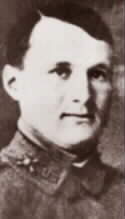 SKC Films Library SKC Films Library |
| SKC Films Library > Technology > Aeronautics > Biography |
| Thomas Selfridge the first person to die in an airplane crash
Thomas Etholen Selfridge was born in San Francisco, California, in 1882. He was appointed to the Military Academy at West Point, and graduated with the class of 1903. Keenly interested in the young field of aeronautics, Selfridge became interested in the work of Alexander Graham Bell, who was building kites with great lifting capacity near Baddeck, Nova Scotia. Selfridge wrote Bell asking permission to witness some of the experiments. Bell was so impressed with Selfridge that he convinced President Theodore Roosevelt to assign him to Baddeck as an official observer. On October 1, 1907, Selfridge, Bell, Glenn Hammond Curtiss, and two other men formed the Aerial Experiment Association, of which Selfridge was made Secretary. The Association's first project was a kite called Cynet I, which had several thousand tetrahedral cells and measured over 42 feet across. On December 6, 1907, Selfridge "piloted" the kite to a height of 168 feet over Lake Bras d'Or. He remained aloft for seven minutes before the wind dropped and the kite settled to the water. In early 1908, Selfridge designed the Association's first airplane. It was called the Red Wing because of its red silk covered wings. The Association next built the White Wing, which incorporated hinged ailerons. On May 19, 1908, Selfridge became the first Army officer to make an airplane flight in America when he flew the White Wing a distance of 100 feet at Hammondsport, New York. The Association's third airplane, the June Bug, won the Scientific American Trophy for a flight of over one kilometer. The fourth airplane, the Silver Dart, became the first airplane to be flown in Canada. The Association also offered the first airplanes for sale in America, for $5,000 each, with delivery in sixty days. In August 1908, Selfridge was assigned to an official Army Board responsible for testing the Army Signal Corps' first dirigible at Fort Myer, Virginia. Selfridge made several flights in the dirigible before it was officially accepted. Selfridge was next assigned to a board conducting the first trials of the Wright airplane to see if it could fly 40 miles an hour, carry two persons aloft, and be portable enough to be transported by mule-drawn wagon. For two weeks, Selfridge watched as the airplane broke record after record. On September 17, 1908, Selfridge climbed into the passenger seat to fly with Orville Wright. The airplane was flying about 150 feet over Fort Myer when Wright began a slow turn. All of a sudden the airplane began to shake violently and then made a sudden turn to the right -- the propellor had just snapped off. Wright tried to wrest control of the airplane, but was unable to do so. The airplane slammed almost nose-first into the ground. When the anxious onlookers got to the scene they found Wright conscious but obviously seriously injured. Selfridge was unconscious and also obviously seriously injured. Wright suffered several broken bones and spent several weeks in the hospital. Selfridge, however, had suffered a severe skull fracture and never regained consciousness. He died the following day, and became the first person to die in an airplane crash. He is buried in Arlington National Cemetery, near the very spot at which he fell to his death. Selfridge in the passenger seat,
alongside Orville Wright the aftermath of the first fatal
airplane crash in aeronautics history SOURCES SEE ALSO |
| SKC Films Library > Technology > Aeronautics > Biography This page was last updated on 05/18/2017. |
